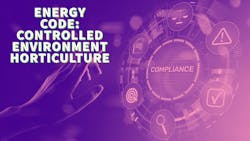In the September 2022 issue of LEDs Magazine, representatives from Energy Code Ace outlined the ways in which lighting designers could optimize general illumination projects to meet California energy code compliance while achieving the required project deliverables for clients. In this article, we explain the value of energy code requirements designed with controlled environment horticulture (CEH) or controlled environment agriculture (CEA) applications in mind. We will address building type definitions, lighting requirements for CEA facilities, and additional resources available for project planning and education.
2022 California Energy Code breakthrough
Horticultural lighting has been subject to California’s Building Energy Efficiency Standards — also known as Title 24, Part 6 or Energy Code — for many years through requirements that apply to a broad range of building types and applications. However, the 2022 Energy Code, which becomes effective Jan. 1, 2023, introduces new standards that specifically address the lighting needs of horticultural applications. These requirements establish distinct photosynthetic photon efficacy (PPE) ratings, as well as time-switch and multilevel lighting controls, which ensure adequate light to support indoor growing without wasting energy when natural light is readily available or when electric lighting isn’t required, for example.
In addition to lighting, the code addresses the importance of proper temperature and humidity conditions through requirements for the building envelope and for HVAC and water heating systems. Any CEH facility owner or contractor in California that applies for a permit on or after Jan. 1 will be subject to the 2022 requirements. Indoor facility owners should expect to see a significant reduction on their utility bills as a result of more efficient lighting and lighting control capabilities. For a prototypical building, first-year electricity savings range from 189.5 to 199.0 kWh/ft2of indoor canopy depending on climate zone1. Similarly, greenhouse owners are estimated to receive energy savings ranging from 13.5 to 23.2 kWh/yr/ft2of greenhouse canopy based on a prototypical building. These advanced technologies and controls also offer the ability to optimize conditions to the specific needs of different growing environments, creating a win-win for these facilities.
For projects permitted in 2023 alone, the Codes and Standards Enhancement (CASE) initiative expects the updated code to yield annual savings of 293.9 GWh in electricity and 1.2 million therms in natural gas2. Equivalent to 77,111 metric tons of carbon dioxide emissions or 16,615 gas-powered cars driven for one year3, the savings are significant, but they are only the beginning. The code will continue to evolve as CEH lighting technology and techniques improve. In fact, development of the 2025 California Energy Code is already underway. Interested parties can learn more about how to become involved at Title24stakeholders.com.
The 2022 California Energy Code has different lighting requirements based on the type of CEH space. It is therefore critical for designers and builders to understand which category a space falls into by paying close attention to the definitions for CEH Space, Indoor Growing, Conditioned Greenhouse/Conditioned Space, and Process Space found in Section 100.1 of the 2022 Energy Code. (See “Key terms defined” sidebar.)
Key terms defined
CEH Space
- A building space dedicated to plant production by manipulating indoor environmental conditions, such as through electric lighting, irrigation, mechanical heating, mechanical cooling, or dehumidification.
- Note: CEH space does not include building space where plants are grown solely to decorate that same space.
Indoor Growing
- A type of CEH space in a building with a Skylight Roof Ratio (SRR) less than 50%.
- Growing plants in a warehouse with or without skylights is an example of indoor growing.
Conditioned Greenhouse/Conditioned Space
- A greenhouse/enclosed space that is provided with wood heating, mechanical heating that has a capacity exceeding 10 Btu/hr-ft², or mechanical cooling that has a capacity exceeding 5 Btu/hr-ft².
- Note: Greenhouses are defined as having a SRR greater than or equal to 50%.
Process Space
- A nonresidential space that is designed to be thermostatically controlled to maintain a process environment temperature less than 55°F or to maintain a process environment temperature greater than 90° F for the whole space that the system serves, or that is a space with a space-conditioning system designed and controlled to be incapable of operating at temperatures above 55°F or incapable of operating at temperatures below 90°F at design conditions.
- An example would be a greenhouse in which the heating system is thermostatically limited to below 55°F to prevent freezing.
Photosynthetic photon efficacy (PPE)
- Photosynthetic photon flux divided by input electric power in units of micromoles per second per watt, or micromoles per joule as defined by ANSI/ASABE S640.
Time-Switch Controls
- Automatic time-switch control controls lighting based on time of day.
- Astronomical time-switch control controls lighting based on the time of day and astronomical events such as sunset and sunrise, accounting for geographic location and calendar date.
Multilevel Lighting Controls
- Multilevel lighting controls reduce power going to a lighting system in multiple steps. One example of these multiple steps would be continuous dimming between 10–100% of full rated power.
Horticultural lighting requirements
In addition to the type of CEH space, horticultural lighting requirements depend on the total aggregate load. When the aggregate horticultural lighting load is less than or equal to 40 kW, the California Energy Code horticultural lighting requirements do not apply. However, the multilevel astronomical time-switch control requirements of Section 140.6(a)3G will apply. When the aggregate load is greater than 40 kW, the following requirements apply to the electrical lighting system used for plant growth and plant maintenance.
- All horticultural lighting must have a PPE rated in accordance with ANSI/ASABE S640 for wavelengths from 400 to 700 nm.
- All horticultural lighting must be controlled with time-switch and multilevel lighting controls.
- Greenhouse luminaires must have a Rated PPE of at least 1.7 micromoles per joule (µmol/J).
- Indoor grow space luminaires must have a Rated PPE of at least 1.9 µmol/J.
- Indoor grow space electric power distribution must be designed so that a measurement device is capable of monitoring the electrical energy usage of aggregate horticultural lighting loads (new construction only).
Tip: Don’t forget general lighting
After lighting designers and builders ensure their project complies with the Title 24 requirements specific for CEH, they also need to look at their general lighting as well. General lighting is defined as “installed electric lighting that provides a uniform level of illumination throughout an area, exclusive of any provision for special visual tasks or decorative effect exclusive of daylighting, also known as ambient lighting4.” General indoor lighting requires several types of lighting controls and automated demand response, while outdoor lighting requires a luminaire cutoff in addition to lighting controls.
Keeping current
Lighting and building professionals involved in the CEH market should stay on top of the latest energy codes, as well as the latest technologies and design practices to increase energy savings and productivity. While 2022 Title 24, Part 6 represents the first energy code specific to CEH, these requirements will likely evolve and be adopted in other states or jurisdictions. Designers and builders can stay up to date by utilizing the nearby Resources list, which includes links to informational mailings and newsletters.
Resources
California Workforce and Education Training Program
As part of the California Statewide Workforce and Education Training Program, San Diego Gas & Electric offers a variety of agricultural classes, including Controlled Environments for Commercial Cannabis Cultivators and Cannabis Goes Green: Water & Energy Conservation at New Grow Facilities.
PG&E also provides professional training, a robust tool-lending library and real-time access to industry experts, all at no cost. The course on Indoor Agricultural Lighting Fundamentals introduces the fundamentals for lighting plants in indoor grow environments.
Energy Code Ace
Energy Code Ace offers tools, training, and resources to decode the requirements of Title 24, Part 6, including a Code Breaker webinar on CEH for the 2022 Energy Code. This webinar details all the requirements for CEH spaces, including those for envelope and mechanical elements as well as electrical.
For more information on horticultural lighting, see the Energy Code Ace and Statewide Workforce Education and Training Program websites.
REFERENCES
1. 2022 Controlled Environment Horticulture Final Codes and Standards Enhancement (CASE) initiative Report, pp. 68–74.
2. Title 24 2022 Code Impacts, Electricity Savings by Top 10 Measures and Natural Gas Savings by Top 10 Measures.
3. US Environmental Protection Agency, Greenhouse Gas Equivalencies Calculator.
4. Energy Code Ace glossary, 2022 Building Energy Efficiency Standards for Residential and Nonresidential Building Title 24, Part 6.
5. Energy Code Ace glossary, 2022 Building Energy Efficiency Standards for Residential and Nonresidential Building Title 24, Part 6.
EILEEN EATON, GINA RODDA, and JASMINE SHEPARD represent Energy Code Ace, a program that assists utility customers and lighting/building project teams through no-cost tools, training, and resources to decode the requirements of Title 24, Part 6 and Title 20.
The article authors work on behalf of Energy Code Ace and its programs.
For up-to-the-minute LED and SSL updates, follow us on Twitter. You’ll find curated content and commentary, as well as information on industry events, webcasts, and surveys on our LinkedIn page and our Facebook page.





